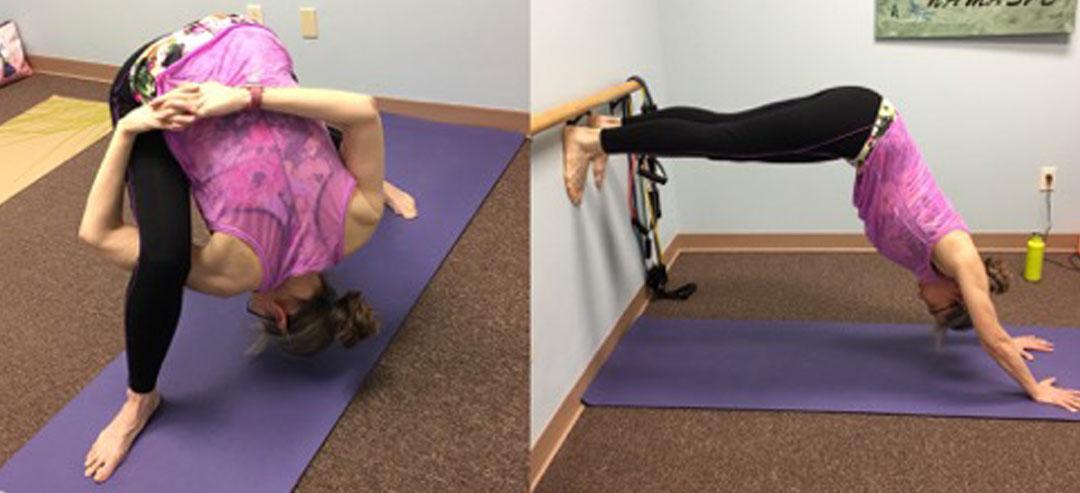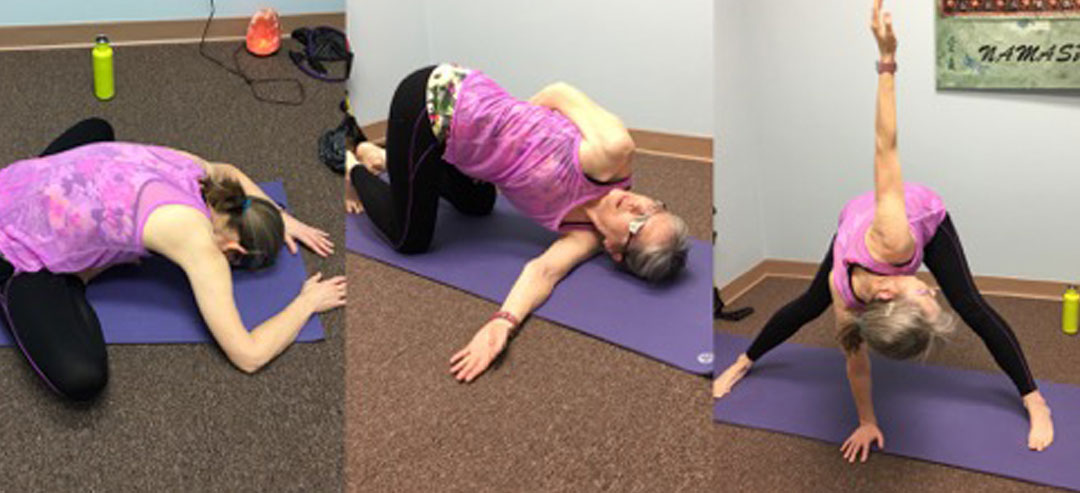How one North Liberty woman fought back against fibromyalgia pain with diet & exercise–and won.

NO MORE PLAYING THE PAIN GAME
After years of sedentary living to avoid pain triggers, North Liberty woman creates care team, eliminates fibromyalgia pain through diet and exercise.
A diagnosis of fibromyalgia – a syndrome that affects muscle and soft tissue, causing chronic pain and fatigue – would in itself be a tough diagnosis to bear.
When Deb Cannon, 61, of North Liberty, was diagnosed in 1993, fibromyalgia was way down on her list of diagnoses to take care of. She spent the next 12 years “bouncing around” traditional medicine to treat a host of other issues, such as endometriosis, migraines, severe allergies, and occipital and trigeminal neuralgia.
“Just getting down to fibromyalgia was a huge success,” Cannon said.
Cannon worked as an information technology manager until, in her 40s, her chronic pain became so fierce she had a breakdown and had to stop working. She spent the next three months mostly sleeping.
“If everything hurts, what’s the point?” Cannon said.
It was a friend who encouraged her to get up off the couch and start exercising. Cannon began seeing a functional medicine doctor, who helped her drastically change her diet and exercise routine. According to the Institute for Functional Medicine (www.ifm.org), the Functional Medicine model is an individualized, patient-centered, science-based approach that empowers patients and practitioners to work together to address the underlying causes of disease rather than symptoms.
Her self-rating on the pain scale went from a 10 to about a 5, and she started looking for ways to be more active. She regularly saw a massage therapist, Melicia Patik, who also happened to be a yoga instructor, and she began doing yoga in 2010.
Activity Leads To Injuries
However, doing yoga, she kept activating her body’s triggers that would set off her all-body fibromyalgia pain. She decided to add a Physical Therapist to her “care team” and started seeing Molly Camacho, a Physical Therapist at Performance Health & Fitness in Coralville, in 2012.
“She had gotten to the point with her fibromyalgia that she had more energy and less pain, so she was able to be more active; she was able to do yoga. But for a year she’d been getting injured frequently,” Camacho said. “The pain moved around: the neck, shoulders, back. She had a lot of weakness, of muscle imbalance, from years of inactivity, so it wasn’t surprising to me to have her seeing these injuries.”
At the beginning of her therapy, Camacho helped Cannon learn to activate her core stabilization muscles. She taught her simple exercises she could do at home and throughout her day to “turn on” and tighten certain abdominal and back muscles for posture and stabilization of her spine.
“She would hold that muscle, and then have me contract it. At first I couldn’t make my brain contract that muscle. Sometimes it would take a couple sessions,” Cannon said. “Because I meditate, that helped me be able to focus on what muscle she was pointing to.”
An example of this therapy is the Lower Abdominal Bracing Exercise. Camacho had Cannon lay on her back, focus on tightening her lower abdominal muscles, relax, and then repeat.
“When (clients) learn how to activate those muscles, they start activating them throughout the day, which continues to strengthen them,” Camacho said. “When she was doing yoga, those stabilizer muscles kicked in … she was able to tolerate yoga better and just daily activity as well.”
With fibromyalgia, typically patients don’t tolerate deep-tissue therapy or exercise very well. Camacho used manual therapy and soft tissue mobilization, trying to loosen up Cannon’s tight muscles.
“We try to help people tolerate their exercise routine better,” Camacho said. “We evaluate their range of motion and the strength of the whole body, then find ways to reduce muscle imbalance.”
Cannon’s exercises became gradually more progressive.
“The nice thing about working with Deb is that she’s already so active, doing yoga and muscle training. I didn’t have to create a whole exercise routine,” Camacho said. “She had the determination and dedication. She knew she had to be active, and she really educated herself.”
Cannon’s care team now consists of a yoga instructor, physical therapist (Camacho), chiropractor and functional medicine doctor. Camacho’s role is neuromuscular, making sure her flexibility and range of motion are where they should be.

Proprioceptive Training
Cannon and Camacho began working on Cannon’s “trigger” spots – areas of her body that, when touched or injured, would cause a full-body alarm in Cannon’s brain and start her pain symptoms.
Cannon termed this work “proprioceptive training.” The proprioceptors are the sense organs throughout the body, including the joint receptors, which signal to the brain about joint angles.
“Proprioception had basically been responsible for my brain misfiring all these years,” Cannon said. “The answer was to strengthen those muscles that were being triggered.”
Cannon said they are working on her last trigger spot right now, which is her right tricep.
“When I’m not in a ‘Molly-induced trauma,’ my pain level is at a 0 to 1,” Cannon said. “I think after my right tricep is cured, I won’t need medicine anymore.”
‘Food Is So Critical To My Story’
Cannon has also made drastic changes to her diet, eliminating dairy (which cured her joint pain), grains and processed sugar.
One of her sources of dietary information is Dr. Mark Hyman, the Medical Director at Cleveland Clinic’s Center for Functional Medicine, Founder of The UltraWellness Center, and a New York Times Bestselling Author. Dr. Hyman offers a free podcast, “The Doctor’s Farmacy,” available at drhyman.com.
Cannon also was inspired by the movie “Fed Up,” a documentary in which director Stephanie Soechtig and journalist Katie Couric investigate how the American food industry may be responsible for more sickness than previously realized, namely the sugar industry.
“Food is so critical to my story,” Cannon said. “It feels like I can think more without sugar.”
Advice To Others
Many fibromyalgia patients may be afraid to try exercise because it has caused flare-ups in the past. However, while doing nothing may feel better in the short term, long-term it’s going to cause other health problems. Sedentary lifestyles have been shown to increase people’s risks of heart attacks and developing diabetes and sleep apnea.
“Diet and exercise. That’s the last thing you wanna hear when you’re hurting. But you gotta get up off that couch,” Cannon said.
She realizes that other fibromyalgia patients may not have the time or monetary ability to address their symptoms the way she did.
“A lot of fibromyalgia patients that I know of or have read about, aren’t willing to or simply can’t change their lives that drastically,” Cannon said.
Knowing how empowering functional medicine and self-education have been for her, Cannon emphasizes to other fibromyalgia patients that “you’re in charge of your health care. You make your decisions, and if it doesn’t feel right, don’t do it.”
“What worked for Deb might not work for others. Every person is different,” Camacho said. “We talk to each person, and then come up with a plan. We continually evaluate; if things aren’t working, we make adjustments to the plan.”
Best Shape of Her Life
Camacho has seen a vast difference between the Cannon she first saw six years ago to now.
“She is more confident in her physical abilities. She’s happier because she’s able to be more active. She is able to go for bike rides with her husband and grandkids,” Camacho said. “She doesn’t take it for granted. She really understands that she’s come a long way and accomplished a lot.”
Cannon now operates Spirited Healing Arts in Solon and is a Spiritual director, Yoga Instructor, and Reiki Master.
She doesn’t want to take the credit for her success on her own shoulders. “Proud would imply that I did it alone. I really feel there is a purpose, a meaning to my story,” Cannon said. “I’m humbled by my success.”
